![]()
![]()
![]()
Use LEFT and RIGHT arrow keys to navigate between flashcards;
Use UP and DOWN arrow keys to flip the card;
H to show hint;
A reads text to speech;
34 Cards in this Set
- Front
- Back
|
What is the mechanism of all thoracic spine injuries
|
hyperflexion (bc of fixed kyphosis of the thoracic spine)
|
|
|
Where do most traumatic injuries of the thoraco-lumbar spine occur
|
T12/L1/L2
|
|
|
On lateral plain film views of the thoracic spine are all thoracic vetebrae seen
|
no (T1 and T12 are typically cut off)
|
|
|
What are the mc fractures of the upper thoracic vertebrae
|
compression
|
|
|
What part of the vetebrae is typically involved in a compression fracture
|
anterior
|
|
|
What percent compression of the anterior portion of the thoracic spine is need for a simple compression and severe compression fracture
|
simple >10%
severe >50% |
|
|
Is neurologic deficit common with sever compression fractures
|
yes, they are mechanically unstable and there may be retropulsion of fragments
|
|
|
What are the vetebrae of the thoracolumbar junction
|
T12/L1/L2
|
|
|
What is the part of the thoracic spine most injured during traumatic injuries
|
thoracicolumbar
|
|
|
Is a jump from a height a common cause of a thoracicolumbar injury
|
yes
|
|
|
Besides a comminuted compression fracture what is associated with a fall from a height
|
a calcaneal fracture
|
|
|
What is the most common cause of a chance fracture
|
fall in flexion position and the 2nd most common is lap seat belts
|
|
|
What is the mechanism of of a chance fracture
|
distraction injury of the posterior portion and impaction of the anterior vetebral body
|
|
|
Describe a chance fracture
|
horizontal fx through the spinous process, lamina, pedicles and vetebral body
|
|
|
What is a chance fracture associated with 50% of the time
|
an abdominal injury
|
|
|
What abdominal organs are typically injured in a chance fracture
|
pancreas
doudenum mesentery |
|
|
What is worrisome if there is a transverse process fracture in the region of L2
|
a renal injury
|
|
|
Spondylolysis
|
spond -de-lal-lysis
|
|
|
What is the mechanism by which spondylolysis occurs
|
defect in the pars
|
|
|
Spondylolisthesis
|
spond-de-lal-listhesis
|
|
|
Where is the pars in the oblique view
|
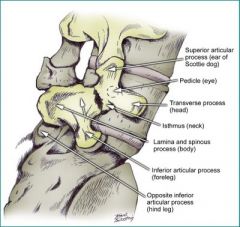
|
|
|
Where is the pars in this oblique view (scotty dog)
|
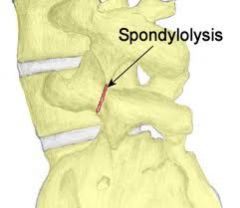
|
|
|
What does a scoty dog look like on oblique x ray
|
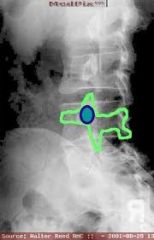
|
|
|
Where is the pars located
|
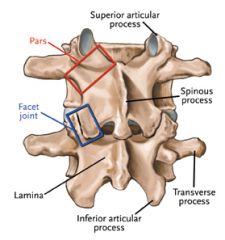
located between the inferior and superior articular processes of the facet joint (same vetebrae...not inferior and superior of a connecting joint)
|
|
|
Where is the pars in this oblique view
|
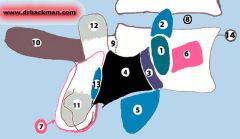
Pedicle (right)
2. Superior articular process (right) 3. Pars interarticularis / isthmus (right) 4. Lamina (right) 5. Inferior articular process (right) 6. Transverse process (right) 7. Spinous process 8. Intervertebral disc 9. Interlaminar space 10. Transverse process (left) 11. Inferior articular process (left) 12. Superior articular process (left) 13. Lamina (left) 14. Vertebral body |
|
|
What does a bilateral pars defect look like on CT
|
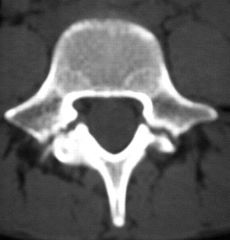
Note that the pars are posterior to the transverse process
|
|
|
What is the anatomy of scoty dog
|
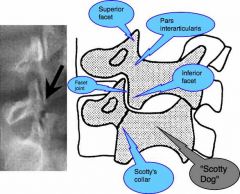
|
|
|
Where is the pars on transverse plane
|
In the transverse plane, it lies between the lamina and pedicle
|
|
|
What is the pars closer too the inferior or superior articular facet
|
the superior articular facet
|
|
|
What does a pars defect look like on sagital CT
|
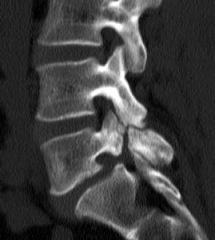
Note that if both pars break the posterior element will move posteriorly. Note that it looks like the inferior portion of the posterior veterbral element is breaking of while the superior articular facet stays attached to the vetebral body. This occurs even though the pars fracture occurs closer to the superior articular facet.
|
|
|
What happens when there is a bilateral defect of the pars interarticularis
|
spondylolisthesis
|
|
|
What is spondylolisthesis
|
forward slippage a vetebral body
|
|
|
What are the important fractures to know of the thoracolumbar spine
|
simple compression
severe compression chance fracture axial loading (fall fracture..burst fracture) transverse process fracture traumatic spondylolysis |
|
|
What is the difference between perched and locked facet
|
is a vertebral facet joint whose inferior articular process on one side appears to sit 'perched' on the superior articular process of the vertebra below. If it gets rotated any more it will slip down the opposite side and become locked
|

